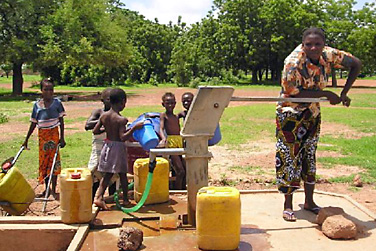News
Researcher tackles global sanitation crisis

A 2005-06 survey of 35 developing countries found that women make up 64 percent of the population responsible for collecting water—a time-consuming and often hazardous task. Photo: PAVANI RAM
Feces, fluids, fields, fingers and food. Combine these with a susceptible host and you get easily spread, yet easily preventable, diarrhea-related diseases.
The image isn’t pleasant, but neither is the reality, says Pavani K. Ram, assistant professor in the Department of Social and Preventive Medicine, School of Public Health and Health Professions.
Before Ram joined the UB faculty in 2005, she was an epidemiologist studying disease outbreaks at the Centers for Disease Control and Prevention. At UB, she focuses on prevention of high-burden diseases, such as diarrheal disease and acute respiratory infections, which are prevalent in low-income countries in Africa and Asia.
Ram’s goal is to improve public health by using improved data on hand washing to develop effective health promotion campaigns, both abroad and here in the United States.
About 2.5 billion people worldwide do not have access to “improved” bathroom facilities, which are defined as private—not public or shared—toilet facilities that remove or treat human waste. Ninety percent of the raw sewage produced in low-income countries is released untreated into the environment, where it pollutes food and water sources used for agriculture, washing and drinking.
The downstream impact of this pollution on low-income countries is two-fold. Diarrheal diseases are the second-leading cause of death in children living in low-income countries, and cause 2.5 million deaths among adults and children annually.
Poor sanitation also affects social development. For example, women are the primary water collectors in many developing countries and are therefore exposed to unclean water supplies. Women and girls who are menstruating also tend to avoid public toilets, risking their personal safety and education by using isolated facilities at night or staying home from school.
The complicated situation has prompted the United Nations and UNICEF to designate 2008 as the International Year of Sanitation, a campaign to encourage better sanitation system development. This could be as simple as installing composting toilets or pit latrines in every town and educating residents in how to use them, or constructing more complex “biogas” systems where methane, a byproduct of human waste, is collected from public latrines and then converted into electricity. Composting toilets can contain waste until it is ready to be treated for use as an agricultural fertilizer.
Although sanitation development has been undervalued as a public health policy issue, Ram says, governments of poor nations are beginning to take notice because of its proven economic and social benefits.
“The United Nations estimates that $9 is generated for each $1 spent on improved sanitation, so the economic impact is huge,” she says. “Not to mention the lives saved through the simplest and cheapest of daily habits.”
In an ongoing study funded by the Water and Sanitation Program of the World Bank, Ram and an international team of researchers are evaluating the effectiveness of promoting hand-washing with soap at large scale. This project has the potential to demonstrate improved hand-washing behavior, as well as hand-washing’s impact on diarrhea morbidity and other child development metrics.
Data on hand washing has been traditionally collected by observational studies, but now Ram and her colleagues are using a high-tech soap developed by a global consumer-products corporation. Inside each bar is a small motion-sensor device that can help pinpoint when and how often people use the time-tested method of soap and water for washing hands. The data coming out of these studies is much more accurate, Ram says.
In another study, Ram is looking at why antimicrobial agents are preferred by caregivers of children and health workers over simple oral rehydration therapy for diarrhea management. Despite their popularity, these agents are not effective in half or more of diarrhea episodes, and unnecessary use promotes the spread of drug-resistant pathogens.
In Erie County, her group will evaluate a hand hygiene promotion program, which includes the use of waterless hand sanitizers, in order to examine its impact on hand cleansing practices and absenteeism in public schools.

Reader Comments